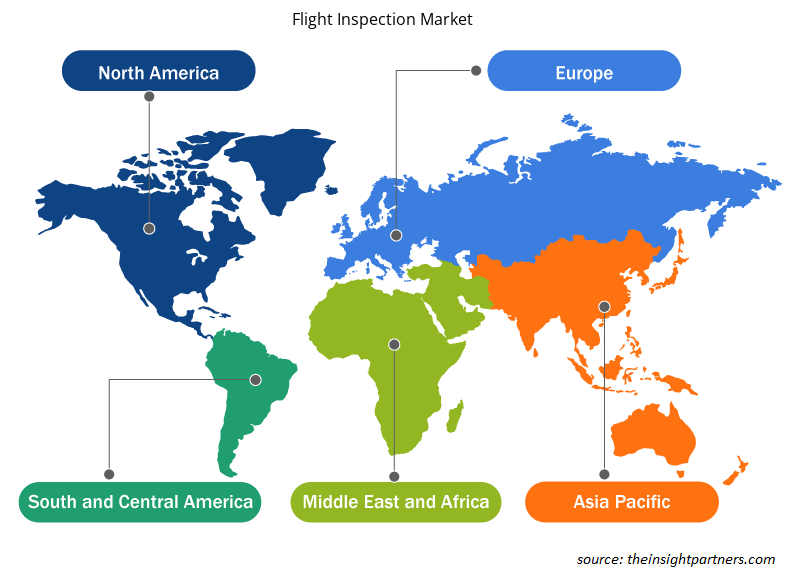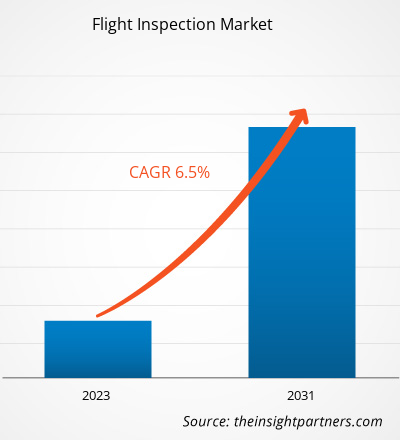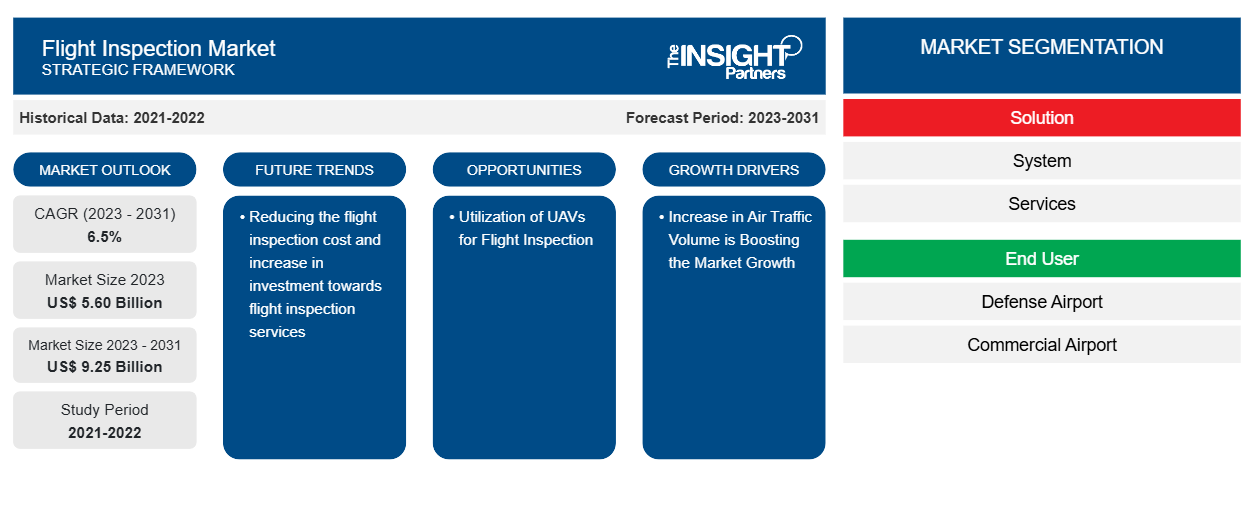Der Markt für Fluginspektionen soll von 5,60 Milliarden US-Dollar im Jahr 2023 auf 9,25 Milliarden US-Dollar im Jahr 2031 anwachsen. Der Markt soll zwischen 2023 und 2031 eine durchschnittliche jährliche Wachstumsrate (CAGR) von 6,5 % verzeichnen. Die wichtigsten Trends, die den Markt für Fluginspektionen antreiben, sind die Senkung der Fluginspektionskosten und die Erhöhung der Investitionen in Fluginspektionsdienste.
Fluginspektion Marktanalyse
Der zunehmende Flugverkehr erforderte die Einrichtung eines gemeinsamen Flugvermessungssystems für alle Flugsicherungseinrichtungen, um die Landevorgänge von Flugzeugen effektiver zu handhaben. Die rasante Entwicklung der Flugzeugtechnologien, wie z. B. fortschrittliche Navigations- und Kommunikationssysteme, erfordert verbesserte Inspektionssysteme und -dienste. Die steigende Zahl von Flugzeugen im kommerziellen und militärischen Sektor aufgrund steigender Passagierzahlen und Verteidigungseinsätze treibt das Marktwachstum an. Entwicklungsländer sind ein potenzieller Markt für Unternehmen, da die zunehmende Zahl von Flughäfen eine lukrative Gelegenheit für bodengestützte Flugvermessungssysteme bietet. Die Weiterentwicklung von Flugvermessungssystemen reduziert Betriebszeit und -kosten und bietet Kunden kostengünstige Lösungen.
Marktübersicht für Fluginspektionen
Die globale Luftfahrtindustrie erlebt aufgrund der steigenden Zahl internationaler und inländischer Flüge ein beträchtliches Wachstum. Dies wiederum treibt das Wachstum des Flugvermessungsmarktes voran. Die steigende Zahl von Flugzeugen auf Flughäfen erzeugt die Nachfrage nach fortschrittlichen Flugvermessungssystemen und -diensten, um sicherzustellen, dass Flugzeuge flugsicher und flugtauglich sind. Die Bedeutung der Flugvermessung wächst, da moderne Flugzeuge mit einem komplexen System ausgestattet sind und zusätzliche Fähigkeiten zur Überprüfung erfordern. Ausgebildete und lizenzierte Inspektoren führen den Inspektionsprozess durch, um die Leistung von Navigations-, Überwachungs- und Kommunikationssystemen zu messen. Die Flugvermessung gewährleistet die Sicherheit beim Start und bei der Landung von Flugzeugen. Darüber hinaus steigern erhöhte Sicherheitsstandards und verbesserte Richtlinien für Flughafenterminals die Bedeutung von Flugvermessungssystemen. Darüber hinaus reduziert der zunehmende Einsatz automatischer Flugvermessungssysteme die Betriebszeit und verbessert die Prozesseffizienz. Aufgrund ihrer zeit- und kostensparenden Vorteile steigt die Nachfrage von Flughafeneinrichtungen nach automatisierten Flugvermessungssystemen zur Durchführung von Flugvermessungen.
Passen Sie diesen Bericht Ihren Anforderungen an
Sie erhalten kostenlose Anpassungen an jedem Bericht, einschließlich Teilen dieses Berichts oder einer Analyse auf Länderebene, eines Excel-Datenpakets sowie tolle Angebote und Rabatte für Start-ups und Universitäten.
-
Holen Sie sich die wichtigsten Markttrends aus diesem Bericht.Dieses KOSTENLOSE Beispiel umfasst eine Datenanalyse von Markttrends bis hin zu Schätzungen und Prognosen.
Treiber und Chancen auf dem Fluginspektionsmarkt
Anstieg des Luftverkehrsaufkommens fördert das Marktwachstum
Der globale Luftfahrtsektor verzeichnet ein deutliches Wachstum des Flugverkehrsvolumens in Bezug auf Passagierzahlen und Flugzeugflotte. Angesichts der Zunahme der Flugzeugflotte und des Verkehrsvolumens sind Routineinspektionen für Flughafenbehörden von größter Bedeutung, um den reibungslosen Ablauf der Flugbewegungen zu gewährleisten . Neben Routineinspektionen werden in mehreren Ländern auch Inspektionsdienste in Auftrag gegeben, da in Industrie- und Entwicklungsländern zahlreiche neue Flughäfen entstehen. In den letzten Jahren haben mehrere Flughafenbehörden in den Ausbau von Start- und Landebahnen und Terminals investiert. Es wird erwartet, dass die Region Asien-Pazifik erheblich zum Wachstum des Fluginspektionsmarktes beiträgt, da die Flughafenbehörden in Ländern wie China, Indien, Japan und anderen südostasiatischen Ländern in den Ausbau bestehender Flughäfen und den Bau neuer Flughäfen investieren. Eine stärkere Neigung zu Fluginspektionsaktivitäten, ein Wachstum beim Bau neuer Flughäfen, eine steigende Zahl von Fluginspektionsdienstleistern und ein Anstieg des Flugverkehrsvolumens sind daher die Schlüsselfaktoren, die das Wachstum des Fluginspektionsmarktes katalysieren.
Einsatz von UAVs zur Flugvermessung
Unbemannte Luftfahrzeuge ( UAVs ) haben weltweit in zahlreichen Branchen und Anwendungsbereichen enorme Vorteile gezeigt. Mehrere UAV- Hersteller haben die Bedeutung der Fluginspektion im Laufe der Jahre erkannt und erwägen nun die Einführung und Unterstützung von Flughafenbehörden und Fluginspektionsdienstleistern beim Einsatz von UAVs . Canard Drones Ltd., ein spanischer Drohnenhersteller, gehört zu den Vorreitern in der Entwicklung und Vermarktung von Drohnen für Fluginspektionen und Inspektionstätigkeiten. Das Unternehmen rechnet damit, dass der Einsatz von Drohnen die Fluginspektionstätigkeiten revolutionieren wird, indem der Zeitaufwand für Routineinspektionen verkürzt und die Kosten gesenkt werden. Ebenso hat AltiGator , ein belgischer Drohnenhersteller, das UAV ATLAS entwickelt , um Fluginspektionstätigkeiten anzubieten. Da Drohnen viel kleiner sind und weniger Nutzlast tragen können als Flugzeuge, wird von den Herstellern von Fluginspektionsgeräten erwartet, dass sie kompakte, leichte und leistungsfähige Systeme einführen, die auf den UAVs installiert werden können , um Fluginspektionen durchzuführen. Daher wird erwartet, dass Innovationen im Bereich kleiner, leichter Flugvermessungsgeräte für Drohnen den Flugvermessungsmarkt in den kommenden Jahren ankurbeln werden. Darüber hinaus legen die für die Flugvermessung zuständigen Behörden Wert darauf, die Voraussetzungen der Flugvermessungsverfahren zu ändern, um eine UAV-basierte Flugvermessung ( UFIS ) durchführen zu können. Die Änderungen würden den Flughafenbehörden und Flugvermessungsdienstleistern zugutekommen, was wiederum das Wachstum des Flugvermessungsmarktes ankurbeln dürfte.
Segmentierungsanalyse des Fluginspektionsmarktberichts
Wichtige Segmente, die zur Ableitung der Marktanalyse für Fluginspektionen beigetragen haben, sind Lösung und Endbenutzer.
- Basierend auf Lösungen wurde der Markt für Flugvermessung in Systeme und Dienstleistungen unterteilt. Das Systemsegment hatte im Jahr 2023 einen größeren Marktanteil.
- Auf der Grundlage des Endnutzers wurde der Markt in Verteidigungsflughäfen und Verkehrsflughäfen segmentiert. Das Segment der Verkehrsflughäfen dominierte den Markt im Jahr 2023.
Marktanteilsanalyse für Fluginspektionen nach geografischer Lage
Der geografische Umfang des Marktberichts zur Fluginspektion ist hauptsächlich in fünf Regionen unterteilt: Nordamerika, Europa, Asien-Pazifik, Naher Osten und Afrika sowie Südamerika.
Nordamerika hat den Fluginspektionsmarkt im Jahr 2023 dominiert. Die Region Nordamerika umfasst die USA, Kanada und Mexiko. Die Luft- und Raumfahrtindustrie in Nordamerika ist ausgereift und verfügt über eine große Anzahl von Flugzeugherstellern, MRO-Dienstleistern und qualifizierten Arbeitskräften. Die Nachfrage nach fortschrittlichen Technologien ist in der Region enorm, und alle oben genannten Endnutzer sind sich neuerer Technologien bestens bewusst. Aus diesem Grund begann die Einführung von Fluginspektionslösungen in kommerziellen Flughäfen in der Region vor Jahrzehnten und die Technologie wird weiterhin in die neuen Flughafenanlagen integriert. Der kommerzielle Luft- und Raumfahrtsektor in der Region wird hauptsächlich von Boeing dominiert, das auch seine Modelle B787 und B777 zur Inspektion integriert, um sicherzustellen, dass Flüge den erwarteten Standards entsprechen und sicher flugfähig sind. Die Fluginspektionsdienstleister und Flughäfen mit eigenen Fluginspektionssystemen haben begonnen, ältere Flugzeuge mit modernen Navigationshilfen nachzurüsten, was ebenfalls ein Katalysator für den nordamerikanischen Fluginspektionsmarkt ist. Die Präsenz einer großen Zahl von Anbietern von Flugvermessungslösungen in der Region unterstützt die ständig steigende Nachfrage und belebt somit den Markt für Flugvermessung.
Regionale Einblicke in den Fluginspektionsmarkt
Die regionalen Trends und Faktoren, die den Fluginspektionsmarkt im Prognosezeitraum beeinflussen, wurden von den Analysten von Insight Partners ausführlich erläutert. In diesem Abschnitt werden auch die Marktsegmente und die Geografie des Fluginspektionsmarkts in Nordamerika, Europa, im asiatisch-pazifischen Raum, im Nahen Osten und Afrika sowie in Süd- und Mittelamerika erörtert.

- Erhalten Sie regionale Daten zum Flugvermessungsmarkt
Umfang des Marktberichts zur Fluginspektion
| Berichtsattribut | Details |
|---|---|
| Marktgröße im Jahr 2023 | 5,60 Milliarden US-Dollar |
| Marktgröße bis 2031 | 9,25 Milliarden US-Dollar |
| Globale CAGR (2023 - 2031) | 6,5 % |
| Historische Daten | 2021-2022 |
| Prognosezeitraum | 2023–2031 |
| Abgedeckte Segmente |
Nach Lösung
|
| Abgedeckte Regionen und Länder |
Nordamerika
|
| Marktführer und wichtige Unternehmensprofile |
|
Dichte der Marktteilnehmer für Fluginspektionen: Auswirkungen auf die Geschäftsdynamik verstehen
Der Markt für Fluginspektionen wächst rasant, angetrieben durch die steigende Nachfrage der Endnutzer aufgrund von Faktoren wie sich entwickelnden Verbraucherpräferenzen, technologischen Fortschritten und einem größeren Bewusstsein für die Vorteile des Produkts. Mit steigender Nachfrage erweitern Unternehmen ihr Angebot, entwickeln Innovationen, um die Bedürfnisse der Verbraucher zu erfüllen, und nutzen neue Trends, was das Marktwachstum weiter ankurbelt.
Die Marktteilnehmerdichte bezieht sich auf die Verteilung der Firmen oder Unternehmen, die in einem bestimmten Markt oder einer bestimmten Branche tätig sind. Sie gibt an, wie viele Wettbewerber (Marktteilnehmer) in einem bestimmten Marktraum im Verhältnis zu seiner Größe oder seinem gesamten Marktwert präsent sind.
Die wichtigsten auf dem Flugvermessungsmarkt tätigen Unternehmen sind:
- Aerodata AG
- Airfield Technology, Inc.
- Norwegische Spezialmission AS
- Radiola Limited
- Bombardier Inc.
- ENAV SpA
Haftungsausschluss : Die oben aufgeführten Unternehmen sind nicht in einer bestimmten Reihenfolge aufgeführt.

- Überblick über die wichtigsten Akteure auf dem Fluginspektionsmarkt
Neuigkeiten und aktuelle Entwicklungen auf dem Flugvermessungsmarkt
Der Markt für Fluginspektionen wird durch die Erhebung qualitativer und quantitativer Daten nach Primär- und Sekundärforschung bewertet, die wichtige Unternehmensveröffentlichungen, Verbandsdaten und Datenbanken umfasst. Im Folgenden finden Sie eine Liste der Entwicklungen auf dem Markt für Fluginspektionen und Strategien:
- Im Februar 2024 übernahm Asian Corporate Aviation Management (ACAM) den deutschen Flugvermessungsbetreiber Svege. Durch diese Übernahme erweiterte ACAM seine Präsenz in Europa.
- Im Mai 2022 unterzeichnete Textron Aviation eine Vereinbarung mit Turkish Aerospace Industries für die Fluginspektionsmissionen der türkischen Regierung.
Bericht zum Markt für Fluginspektionen – Umfang und Ergebnisse
Der Bericht „Marktgröße und Prognose für Fluginspektionen (2021–2031)“ bietet eine detaillierte Analyse des Marktes, die die folgenden Bereiche abdeckt:
- Marktgröße und Prognose auf globaler, regionaler und Länderebene für alle wichtigen Marktsegmente, die im Rahmen des Projekts abgedeckt sind
- Marktdynamik wie Treiber, Beschränkungen und wichtige Chancen
- Wichtige Zukunftstrends
- Detaillierte Porter's Five Forces Analyse
- Globale und regionale Marktanalyse mit wichtigen Markttrends, wichtigen Akteuren, Vorschriften und aktuellen Marktentwicklungen
- Branchenlandschaft und Wettbewerbsanalyse, einschließlich Marktkonzentration, Heatmap-Analyse, prominenten Akteuren und aktuellen Entwicklungen
- Detaillierte Firmenprofile mit SWOT-Analyse
- Historische Analyse (2 Jahre), Basisjahr, Prognose (7 Jahre) mit CAGR
- PEST- und SWOT-Analyse
- Marktgröße Wert/Volumen – Global, Regional, Land
- Branchen- und Wettbewerbslandschaft
- Excel-Datensatz
Aktuelle Berichte
Erfahrungsberichte
Grund zum Kauf
- Fundierte Entscheidungsfindung
- Marktdynamik verstehen
- Wettbewerbsanalyse
- Kundeneinblicke
- Marktprognosen
- Risikominimierung
- Strategische Planung
- Investitionsbegründung
- Identifizierung neuer Märkte
- Verbesserung von Marketingstrategien
- Steigerung der Betriebseffizienz
- Anpassung an regulatorische Trends























 Kostenlose Probe anfordern für - Markt für Fluginspektionen
Kostenlose Probe anfordern für - Markt für Fluginspektionen